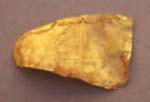ANTHROPOLOGY
Mummies in Alexandria

Gersende Alix, Eric Boës, Patrice Georges and Aurore Schmitt
Gold leaf found in pit 350. It would have been placed in the mouth of a mummy.
Tomb B17, the excavation and architectural analysis of which revealed the complexity of its alterations over the ages, was the object of particular attention due to presence of certain sealed graves undisturbed since antiquity. One pit contained the remains of a body that had been embalmed and undergone brain removal. A facial imprint on a wad of cloth bore little flecks of gold that would have been applied directly to the face. A little sliver of gold leaf in the shape of a tongue was probably placed in the mouth of the deceased, and stands as further proof of the careful preparations of the body. Other mummies were found in coffer burials beneath a funerary monument built within a court dating to the Hellenistic era. The opening of the sealed slabs revealed the remains of the mummified bodies, the bones of which were badly eroded by the embalming materials. On one body the bindings that formed the exterior decoration of the mummy showed geometric patterns characteristic of the Graeco-Roman period (see illustration). Woven gold thread had also been placed under the last layer of bindings.

The Alexandrian paradox
Example of a mummified body discovered in a coffer of limestone slabs beneath a funerary monument dated to the Imperial Roman period.
CGI Eric Boës, all rights reserved
The discovery of mummification in an Alexandrian necropolis is all the more interesting in that juxtaposes two different modes of thought concerning death. Mummified bodies were placed alongside ordinary burials in the same tombs, even coffins. This is unusual and points up a certain paradox. Analysing the management of the tombs has shown that the bodies, mummified or otherwise, were often moved after a period of time in order to leave space for new burials. Fragments of mummified bodies have thus been found with random bones all together in a pit that had been transformed into an ossuary. This collective use of pits and loculi goes somewhat counter to the presumed desire for eternity of those who had been embalmed. There are clearly two different conceptions of the afterlife at play.